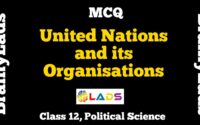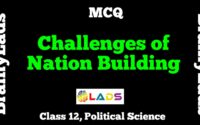MCQ of Cold War Era and Non Aligned Movement, Class 12, Pol. Science
MCQ of Cold War Era And Non Aligned Movement | Class 12 | Political Science |
1) Cuba was an ally of ________
a. USA
b. USSR
c. UK
d. None of the above
ANSWER – USSR
2) Who was the president of Cuba at the time of Cuban Missile Crisis?
a. Fidel Castro
b. John F. Kennedy
c. Kwane Nkrumah
d. Justin Trudeau
ANSWER – Fidel Castro
3) Cold war refers to –
a. The tensions, competition and a series of confrontations
b. Not only a matter of military alliances, power rivalries, and of the balance of power but also a real ideological conflict
c. Both A and B
d. None of the above
ANSWER – Both A and B
4) US represented the ideology of ______ and ______
a. Socialism and Communism
b. Capitalism and Socialism
c. Capitalism and liberal democracy
d. None of the above
ANSWER – Capitalism and Liberal democracy
5) Who was the leader of the Soviet Union at the time of Cuban missile crisis?
a. Mikhail Gorbachev
b. Nikita Khrushchev
c. Fidel Castro
d. Gamal Abdel Nasser
ANSWER – Nikita Khrushchev
You may also go through other subjects like MCQs of Biology, Physics, Chemistry, Music, Accountancy, Business Studies, Economics, Geography, Political Science & English for having a strong hold on the subject with an intent to score higher in the first term examination to be held in the month of November/December.
6) When the Second World War was came to an end?
a. 1946
b. 1945
c. 1941
d. 1948
ANSWER – 1945
7) Which of the following statement is not true about the Cuban missile crisis?
a. Leader of the soviet union decided to convert Cuba into a Russian base
b. The induction of the weapons put the US, for the first time, under fire from close range
c. five weeks after the Soviet Union had placed the nuclear weapons in Cuba, the Americans became aware of it
d. None of the above
ANSWER – Five weeks after the Soviet Union had placed the nuclear weapons in Cuba, the American became aware of it
8) Who was the president of the US at the time of Cuban missile crisis?
a. John F. Kennedy
b. Franklin D. Roosevelt
c. Harry S. Truman
d. Ronald Reagan
ANSWER – John F. Kennedy
9) Soviet Union represented the ideology of ______ and ______
a. Capitalism and Liberal democracy
b. Communism and Capitalism
c. Capitalism and Socialism
d. Socialism and Communism
ANSWER – Socialism and Communism
10) Which of the following country was not among the allied powers?
a) USA
b) USSR
c) Germany
d) Britain
ANSWER – Germany
You may also read Challenges of Nation Building, MCQ of Planning and Development, MCQ of India’s Foreign Policy, for better understanding of the chapters.
11) In the second world war the _____forces, led by the US, Soviet Union, Britain and France defeated the _____ powers
a) Allied, Axis
b) Axis, Allied
c) Power 1, Power 2
d) None of the above
ANSWER – Allied, Axis
12) US dropped two atomic bombs on the Japanese cities of _______ and _______
a) Chiba and Nara
b) Naha and Shizuoka
c) Hiroshima and Kanazawa
d) Hiroshima and Nagasaki
ANSWER – Hiroshima and Nagasaki
13) Cold war was an outcome of the emergence of which two superpowers as opponent to each other?
a) USA an Japan
b) USA and USSR
c) China and Russia
d) None of the above
ANSWER – USA and USSR
14) The western alliance was codified into an organisation named _______
a) SEATO
b) CENTO
c) NATO
d) NAM
ANSWER – NATO
15) NATO came into existence in _______
a) April 1949
b) August 1948
c) July 1948
d) March 1948
ANSWER – April 1949
16)_______ was led by the Soviet Union to counter NATO’s forces in Europe
a) SEATO
b) CENTO
c) NAM
d) Warsaw Pact
ANSWER – Warsaw Pact
17) US dropped two atomic bombs on the Japanese cities of Hiroshima and Nagasaki in _______
a) April 1945
b) August 1945
c) September 1945
d) July 1946
ANSWER – August 1945
18) Which among the following country was not a part of Axis powers?
a) Germany
b) Italy
c) Japan
d) France
ANSWER – France
19) Initially, how many members were there in NATO?
a) 15
b) 12
c) 13
d) 19
ANSWER – 12
20) When communist China and the USSR did fought a brief war over a territorial dispute?
a) 1965
b) 1967
c) 1969
d) 1966
ANSWER – 1969
21) Expand SEATO
a) Southwest Asian Treaty Organisation
b) Southeast Antarctic Treaty Organisation
c) Southeast Arabic Treaty Organisation
d) Southeast Asian Treaty Organisation
ANSWER – Southeast Asian Treaty Organisation
22) Who played a vital role in mediating between the two Koreas?
a) Jawaharlal Nehru
b) John F. Kennedy
c) Mikhail Gorbachev
d) None of the above
ANSWER – Jawaharlal Nehru
23) Superpowers needed allies in gaining access to__________
a) Territory from where they could launch their armaments and troops
b) Location form where they could spy on each other
c) Vital resources, such as oil and minerals
d) All of the above
ANSWER – All of the above
24) Arena refers to –
a) Areas where upheaval and war occurred or threatened to occur between the alliance systems but did not cross certain limits
b) Countries that have agreements to support each other during war
c) Both A and B
d) None of the above
ANSWER – Areas where upheaval and war occurred or threatened to occur between the alliance systems but did no cross certain limits
25) In the Congo crisis, _______ played a key mediatory role
a) Leader of the Soviet Union
b) UN Secretary General
c) Director General of UNESCO
d) King of Nepal
ANSWER – UN Secretary General
26) Expand CENTO
a) Central Treaty Organisation
b) Central Tribal Organisation
c) Central Time Organisation
d) Central Team Organisation
ANSWER – Central Treaty Organisation
27) Where was the first summit of NAM held?
a.Tehran
b. Shimla
c. Accra
d. Belgrade
ANSWER – Belgrade
28) Which of the following was not among the founding members of NAM?
a. Nasser
b. Nkrumah
c. Nana Akufo-Addo
d. Tito
ANSWER – Nana Akufo-Addo
29) First summit of NAM was attended by _____ member states
a) 26
b) 25
c) 21
d) 27
ANSWER – 25
30) 14th summit of NAM was held in ______
a) Havana
b) Hawaii
c) Kathmandu
d) Belgrade
ANSWER – Havana
31) Neutrality refers to –
a) Remaining aloof from world affairs
b) Policy of staying out of war
c) Both A and B
d) None of the above
ANSWER – Policy of staying out of war
32) The United Nations Conference on Trade and Development (UNCTAD) brought out a report entitled ________
a) Towards a New Trade Policy for LDC’s
b) Towards Peace and Development
c) Towards a New Trade Policy for Development
d) None of the above
ANSWER – Towards a New Policy for Development
33) Who headed Western Alliance?
a) USA
b) USSR
c) China
d) None of the above
ANSWER – USA
34) Which of the following statement is not true about India’s response to the cold war?
a) It raised its voice against the newly decolonised countries becoming part of these alliances
b) It took particular care in staying away from the two alliances
c) Both A and B
d) None of the above
ANSWER – Both A and B
35) India signed the Treaty of friendship in August 1971 with the ________ for 20 years
a) USA
b) USSR
c) France
d) Germany
ANSWER – USSR
36) Limited Test Ban Treaty (LTBT) was signed on?
a) 5 August 1963
b) 5 July 1964
c) 6 October 1965
d) 15 March 1963
ANSWER – 5 August 1963
37) Which of the following was not a criticism that India faced over its policy of non alignment?
a) India’s non alignment was said to be ‘unprincipled’
b) India’s non alignment was said to be ‘inconsistent’
c) India’s non alignment was said to be ‘neutral’
d) None of the above
ANSWER – India’s non alignment was said to be ‘neutral’
38) Josip Broz Tito was related to?
a) NATO
b) CENTO
c) SEATO
d) NAM
ANSWER – NAM
39) When was the First World War fought?
a) 1914-1918
b) 1916-1921
c) 1912-1915
d) 1911-1918
ANSWER – 1914-1918
40) What is the full form of NPT?
a) Non-power treaty
b) Non nuclear weapon treaty
c) Non-proliferation treaty
d) None of the above
ANSWER – Non-proliferation treaty
41) According to the Non-proliferation treaty, a nuclear weapon state is one which has manufactured and erupted a nuclear weapon prior to __________
a) 1 January 1965
b) 1 January 1967
c) 1 January 1966
d) 1 January 1968
ANSWER – 1 January 1967
42) Name the treaty signed by the USSR president Mikhail Gorbachev and the US president George Bush on the reduction and limitation of strategic offensive arms in Moscow on 31 July 1991?
a) Strategic Arms Reduction Treaty II
b) Strategic Arms Limitation Talks I
c) Strategic Arms Limitation Treaty II
d) Strategic Arms Reduction Treaty I
ANSWER – Strategic Arms Reduction Treaty I
43) Korean war was fought in ______
a) 1955-58
b) 1957-59
c) 1950-53
d) 1951-53
ANSWER – 1950-53
44) In which year the Soviet Union was disintegrated?
a) 1995
b) 1992
c) 1993
d) 1991
ANSWER – 1991
45) Which among the following countries was not a NATO member?
a) Canada
b) India
c) France
d) Italy
ANSWER – India
Related
Do share this post if you liked the MCQ of Cold War Era And Non Aligned Movement. For more updates, keep logging on BrainyLads



Well planned mcq are there. It will definitely help students
Good questions for cbse board exam… Mcq.. It’s very useful for students 👩🎓 🥰👍🏻👍🏻.. Thanks for these mcq questions 👍🏻👍🏻✌
Thanks for the MCQ’s …… Helped a lot!
Very useful mcq